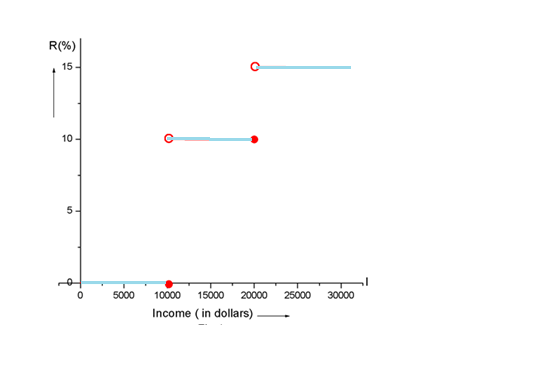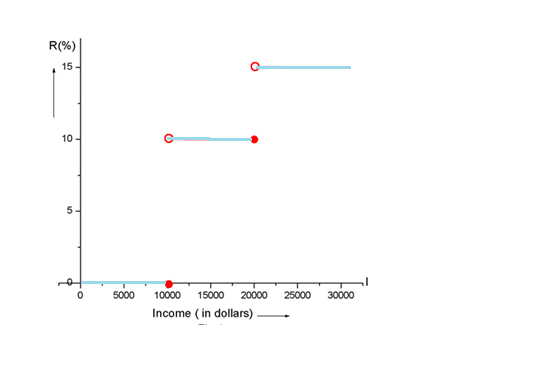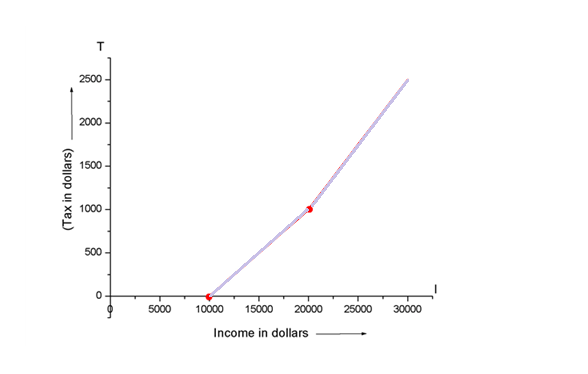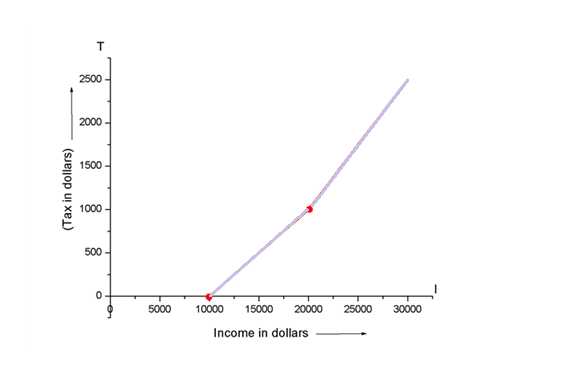
a.
Sketch the graph of the tax rate
a.
Answer to Problem 61E

Explanation of Solution
Given information:
In a certain country, income tax is assessed as follows. There is no tax on income up to
Sketch the graph of the tax rate
Calculation:
Suppose
Now we have been given that, there is no tax income up to
So
If the income
So
If the income is more than
Then
Now we can write the tax rate
Now we can draw a graph,

b.
How much tax is assessed on an income of
b.
Answer to Problem 61E
Explanation of Solution
Given information:
In a certain country, income tax is assessed as follows. There is no tax on income up to
How much tax is assessed on an income of
Calculation:
We have to calculate tax on income of
There is no tax if income
So non-taxable income is =
Then taxable income is =
Since the total income is in the interval
So the income tax =
Hence,
Now, we have to calculate the tax on income of
First we have to break this
Tax on first
Tax on second
Tax on last
Then total tax on income of
Hence, the
c.
Sketch the graph of the total assessed tax
c.
Answer to Problem 61E

Explanation of Solution
Given information:
In a certain country, income tax is assessed as follows. There is no tax on income up to
Sketch the graph of the total assessed tax
Calculation:
Since there is no tax if income
If the income
Maximum taxable income in the interval is
Then maximum tax in this interval =
Hence curve passes through the point
Now if income tax
So tax T (I) =
Or
Hence the graph of tax

Chapter 1 Solutions
Single Variable Calculus: Concepts and Contexts, Enhanced Edition
- please do Q3arrow_forwardUse the properties of logarithms, given that In(2) = 0.6931 and In(3) = 1.0986, to approximate the logarithm. Use a calculator to confirm your approximations. (Round your answers to four decimal places.) (a) In(0.75) (b) In(24) (c) In(18) 1 (d) In ≈ 2 72arrow_forwardFind the indefinite integral. (Remember the constant of integration.) √tan(8x) tan(8x) sec²(8x) dxarrow_forward
- Find the indefinite integral by making a change of variables. (Remember the constant of integration.) √(x+4) 4)√6-x dxarrow_forwarda -> f(x) = f(x) = [x] show that whether f is continuous function or not(by using theorem) Muslim_mathsarrow_forwardUse Green's Theorem to evaluate F. dr, where F = (√+4y, 2x + √√) and C consists of the arc of the curve y = 4x - x² from (0,0) to (4,0) and the line segment from (4,0) to (0,0).arrow_forward
- Evaluate F. dr where F(x, y, z) = (2yz cos(xyz), 2xzcos(xyz), 2xy cos(xyz)) and C is the line π 1 1 segment starting at the point (8, ' and ending at the point (3, 2 3'6arrow_forwardCan you help me find the result of an integral + a 炉[メをメ +炉なarrow_forward2 a Can you help me find the result of an integral a 아 x² dxarrow_forward
 Calculus: Early TranscendentalsCalculusISBN:9781285741550Author:James StewartPublisher:Cengage Learning
Calculus: Early TranscendentalsCalculusISBN:9781285741550Author:James StewartPublisher:Cengage Learning Thomas' Calculus (14th Edition)CalculusISBN:9780134438986Author:Joel R. Hass, Christopher E. Heil, Maurice D. WeirPublisher:PEARSON
Thomas' Calculus (14th Edition)CalculusISBN:9780134438986Author:Joel R. Hass, Christopher E. Heil, Maurice D. WeirPublisher:PEARSON Calculus: Early Transcendentals (3rd Edition)CalculusISBN:9780134763644Author:William L. Briggs, Lyle Cochran, Bernard Gillett, Eric SchulzPublisher:PEARSON
Calculus: Early Transcendentals (3rd Edition)CalculusISBN:9780134763644Author:William L. Briggs, Lyle Cochran, Bernard Gillett, Eric SchulzPublisher:PEARSON Calculus: Early TranscendentalsCalculusISBN:9781319050740Author:Jon Rogawski, Colin Adams, Robert FranzosaPublisher:W. H. Freeman
Calculus: Early TranscendentalsCalculusISBN:9781319050740Author:Jon Rogawski, Colin Adams, Robert FranzosaPublisher:W. H. Freeman
 Calculus: Early Transcendental FunctionsCalculusISBN:9781337552516Author:Ron Larson, Bruce H. EdwardsPublisher:Cengage Learning
Calculus: Early Transcendental FunctionsCalculusISBN:9781337552516Author:Ron Larson, Bruce H. EdwardsPublisher:Cengage Learning





